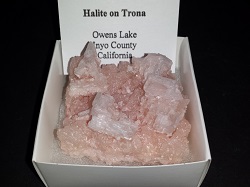HALITE:
Halite, better known as rock salt, can easily be distinguished by its taste. Since taste is an important property of salt,
there is a right way to taste a specimen of halite (or an unknown mineral that is similar to halite) and a wrong way. The right
way is to first lick your index finger, rub it against the specimen and then taste the finger. This limits the amount of the mineral
that actually gets in your mouth, an important consideration when you consider that there are poisonous minerals that resemble halite.
Halite is found in many current evaporative deposits such as near Salt Lake City, Utah and Searles Lake, California in the U.S., where it
crystallizes out of evaporating brine lakes. It is also found in ancient bedrock all over the world where large extinct salt lakes and
seas have evaporated millions of years ago, leaving thick deposits of salt behind.
The cities of Cleveland and Detroit rest above huge halite deposits that are mined for road salt.
Perfectly formed cubes of halite are typical of the habit of this mineral. However it does form some unusual
interesting habits that are much sought after by collectors. One habit is called a hopper crystal which forms what has been termed a
skeleton of a crystal. Just the edges of a hopper crystal extend outward from the center of the crystal leaving hollow stairstep faces
between these edges. Hopper crystals
form due to the disparity of growth rates between the crystal edges and the crystal faces.
Another habit of interest is the vein filling fibrous habit found at Mulhouse, France and at some other localities. Often specimens
are brightly colored purple and blue and with the silky luster due to the fibers, they represent a wonderful and a very uncharacteristic
variety of halide. These specimens are a must have for teachers of mineral identification classes that want a stumper for those end of the
session ID exams. Of course they are still easy to identify with the oft forgot simple taste test.
Well crystallized specimens of halite cubes can be very impressive and popular. Some are colored an attractive pastel pink by inclusions
of bacterial debris that are trapped during crystallization in an evaporative lake. The pink color can fade with time and/or exposure to
sunlight.
Often the specimens that are sold world wide in rock shops and in mineral shows were grown within the past year. In fact, the crystals
form so fast and so well in some evaporative lakes that mineral dealers are using their imaginations to enhance their inventory. They are
putting sticks, animal skulls and other imaginative items into these lakes and retrieving them a relatively short time later covered in
clusters of white or pink halite cubes.

CLICK ON IMAGE TO SEE LARGER PICTURE
|

